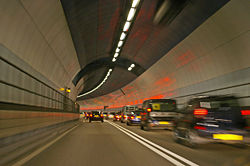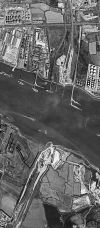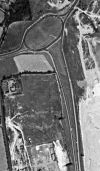Dartford Tunnel
| Dartford Tunnel | |||||
| Location Map ( geo) | |||||
 | |||||
| Going through the tunnel | |||||
| |||||
| From: | Dartford | ||||
| To: | Thurrock | ||||
| County | |||||
| Essex • Kent | |||||
| Highway Authority | |||||
| National Highways | |||||
| Opening Date | |||||
| 1963 (1st Bore) 1980 (2nd Bore) | |||||
| Toll | |||||
| £2.50 (Cars) | |||||
| Additional Information | |||||
| |||||
| On road(s) | |||||
| A282 | |||||
The Dartford Tunnel is a river crossing on the A282 (not the M25 as commonly believed). It spans the River Thames between Dartford in Kent and Thurrock in Essex, carrying northbound traffic. It is one of the most important river crossings in Britain, and indeed in Europe. The current crossing consists of two tunnels and the Queen Elizabeth II Bridge, a cable stayed bridge. The tunnels were built in stages between 1936 and 1980.
History
West Bore
The crossing was originally a single-carriageway tunnel, and carried the name Dartford Tunnel until the opening of the QEII bridge. Initial plans for this tunnel began in the 1920s, with a pilot hole being constructed in 1936 and initial boring works in 1938. As with many other 1930s road projects, work was halted due to the Second World War and work did not resume until 1955.
For the new tunnel the consulting engineers were Mott, Hay and Anderson, and Coode and Partners. The main contractors for the various parts of construction were Chas. Brand and Co. Ltd., Edmund Nuttall, Sons and Co. Ltd., Marples Ridgway and partners Ltd., Sir John Jackson and Co..
The tunnel was 0.9 mile long with 0.25 mile of open cut approaches at a gradient of 1 in 28 from ground level. It had a 28 foot diameter with a 21 foot carriageway. The shell of the tunnel was cast iron, lined with concrete. The road was carried on a reinforced concrete structure and the steel framed suspended ceiling had continuous centrally mounted fluorescent strip lighting. The curved side walls were covered with silver-white vitreous mosaic, designed to reflect light without glare. Each portal had a sun visor consisting of horizontal honeycomb screens of vertical hexagons in light alloy to offset the effect of a driver passing from artificial light into daylight.
The tunnel was planned to connect to the "North Orbital" and "South Orbital" roads, which later became Ringway 3, and 4 miles of approach roads with 24 foot dual carriageways were built from Purfleet Interchange, Thurrock to Princess Road (original Dartford Bypass). It connected the then A13 with A2 (later A1306 and A296) using roundabout junctions. Because the line had not been fixed south of the crossing, there had been little choice but to terminate the southern approach road on the original A2 Dartford Bypass, which was by then heavily congested. The Ministry of Transport and Kent County Council argued over junction arrangements, which were not resolved until early 1963. The tunnel opened to traffic on 18 November 1963. Cost was £11 million.
The tunnel was immediately popular. Although only single carriageway, it was a much higher standard than any other crossing of the Thames east of Tower Bridge, and quickly became the dominant crossing in this area. Consequently, by 1970 there was a strong demand to build a second tunnel, to provide a full dual carriageway link with Ringway 3 and the new Dartford Bypass.
East Bore
Construction on the second tunnel began in 1971, with an original planned opening date of 1976. The project was delayed due to objections at the public enquiry, and finally opened on 16 May 1980. Cost was £37 million.
By this time, the M25 as we now know it had been planned, and sections were either open or under construction. The completion of the section south of Swanley resulted in a substantial increase in traffic, to the extent that a third crossing was announced in 1987. This third crossing became the Queen Elizabeth II Bridge, although it is sometimes referred to as the Dartford Bridge. The bridge opened on the 30th October 1991.
Tolls
The crossing has always been tolled since the first tunnel was opened in 1963. The original toll was 2s 6d for cars, 6s for heavy lorries, 1s for motorcycles and 6d for bicycles. There was initial talk that the toll would be abolished in 1976, based on the then forecasts of repaying the £8 million Exchequer loan, but of course the second bore and the bridge have been built since. The tolls are increasingly controversial. Capital repayment of the crossing was completed in 2003 and local opinion was for the tolls to be axed. The tolls became part-time and since 2012 the charge has been free for motorcycles, £2.00 for cars, £2.50 for 2 axle goods vehicles and £5.00 for multi axle goods vehicles. No charges are levied between 10pm and 6am.
As well as manual toll collection, an electronic tag system called DART-Tag was used, which had a transponder in the windscreen and gave a discounted rate of £1.00 for cars, £1.75 for 2 axle goods vehicles and £3.20 for multi axle goods.
The retention of the tolls has been caused further disquiet due to all tolls in Scotland being axed after devolution, making the tolls a significant local issue for Dartford and the surrounding area. However a local resident scheme has been introduced for an annual fee of £10 locals receive a DART-Tag with 50 journeys included in the price, with further journeys charged at 20p. Disabled drivers are exempt from charge but must pre register their vehicle.
From 30th November 2014 onwards, the toll is no longer collected at toll booths at the southern end of the crossing; instead, ANPR cameras record the registration of vehicles using the crossing, and the charge must be paid either in advance or by midnight the day after the crossing, either online, by phone or in certain shops, in a similar arrangement to the Congestion Charge. At this time the tolls were also increased when payment is made afterwards (eg £2.50 for cars), but reduced for payment in advance (£1.67 for cars, increasing to £2.00 from 01.10.2018).
Initial Tunnel Operation
A closed circuit TV system was fitted at the outset which allowed the controllers at both end of the tunnel to monitor traffic flow. They could activate the emergency signals to stop traffic where problems arose, as well as adjusting the air conditioning and lighting.
Motorists who had a breakdown were advised to wait in their vehicles until receiving assistance from the police breakdown van that cost 30s for the first 15 minutes and £1 for every ten minutes thereafter, a costly affair.
150 people were involved in the daily running of the tunnel.
Cycles
In the very early years, there was a special bus service that ran for bikes, however this wasn't well used so a mini-bus taking the bikes was introduced.
Links




